I recommend Senran Kagura 2 to any and all Nintendo 3DS owners. It has some room for improvement, but is still an absolute must-buy.
Such a game is a bit of a tough act to follow, so I wasn't nearly as excited for Senran Kagura: Estival Versus on the Vita, especially since it follows the more competitive aspect of Shinovi Versus. I still got it, of course, in the Endless Summer Edition that came with a third 2-disc soundtrack, second art book and holographic cards.
That increase in content is indicative of Estival Versus itself, because it's definitely the biggest, fanciest Senran Kagura game yet.
I have to say that is the weakest opening yet, barely indicative of the game at all.
I shouldn't have to point this out, but this review is based on the Playstation Vita version of the game. It's also available on the PS4, but aside from a few presentation perks they're the exact same game. Why it's on the Vita and PS4 instead of the PS3 is very odd, considering it could certainly run the game and is a far superior system to the both of them.
Anyway, Estival Versus' plot is a direct sequel to Shinovi Versus and ignores Senran Kagura 2 completely. It essentially goes by KOF logic regarding Shinovi Versus in that every final chapter of each team is canon with the events beforehand left ambiguous.
In Estival Versus, all the teams from Shinovi Versus are transported to a special island in another world within an extremely powerful shinobi kekkai barrier. There, the restless spirits of dead shinobi are summoned to be put to rest by something of a sending ritual called the Shinobi Bon Dance as part of a cryptic event called the Kagura Millenium Festival. For the most part it's all based around bon festivals in Japan, which, like the Kyoto tour in 2, might lose a few American players that aren't familiar with it.
The whole thing set up by a trio of miko called the Mikagura sisters: The city girl Renka, ditzy Hanabi and pompous Kafuru.
 |
| Renka in the middle, Kafuru on the left and Hanabi on the right. |
 |
| Warning: Still a force to be reckoned with. |
The Mikagura sisters and Sayuri complete their five-woman team with Ryouki, the deceased sister of Ryouna and Ryoubi that served as a major part of their motivations in Shinovi Versus.
 |
| Don't touch that halo. |
On the sliding scale of drama and silliness, Estival Versus leans more toward the comedy hijinks. There's a lot of silliness and heartwarming, saccharine moments fans come to expect that will make many smiles, but when it does get to meaningful character development, Estival Versus is absolutely heart-wrenching. Scenes of the girls reuniting with their loved ones, as well as saying goodbye, are executed perfectly and are full of emotion and heart. At one point it even made me cry. I have seen dramatic death by the truckloads in games, but this is the only one that has been able to get an emotional reaction that excessive out of me. I don't know if that speaks for the game's emotional side or my traumatic experience from losing a loved one, but it's impressive.
Some players might be a little off-put by the story's focus this time. It's one storyline that has to utilize a massive roster of 25 characters and that means some of them get the shaft on character development. Naturally the ones that get the most attention are the ones with deceased shinobi relatives: Miyabi has her mom, the Gessen girls have Kurokage and the Hebijo twins have Ryouki. Homura's squad and the Hanzo students don't have any deceased shionbi loved ones that we know of, so they're left in the background. Asuka has some personal stake in it with her missing grandma being there, and she and the Hanzo students do investigate the purpose of the festival, but compared to the Gessen school, they don't do a whole lot. Asuka even brings this up in one of the game's post-story special missions and it's probably why the Gessen girls are at the top of the character select screen now.
I'm not even kidding when I say that that after the introductory chapters (Day 0), there was never a single mission for Asuka, the character on the cover of every game, until day 6, while she was still at level one. Luckily she leveled up like crazy from that one stage.
The new characters are great additions both to the combat and the story. The Mikagura sisters don't get a lot of character development, but their antics are a lot of fun and Sayuri is nicely defined. She's definitely Hanzo's wife, but is not simply a female version of him, and her smoke-based wind fighting style is creative. There aren't enough badass grandma characters in games and Sayuri is an excellent example of how to make one.
The story as a whole is still decent overall, but I think it's the weakest one yet, and that can be attributed to two enormous factors: There is no sense of urgency or scale and it sets up way too many plot threads with no resolution.
It's hard to get involved in the urgency of the Bon Dance competition when you're never given any indication of how many yaguras each team has left until the final day and everything set up in between feels like a tease. There's a threat established, there's a mention of other worlds, one of the characters coughs up blood several times and is almost certainly dying, the Mikagura sisters are looking for someone that might be Kagura from 2, but none of that ever goes anywhere! There's no payoff! It feels like a filler arc in Naruto: it gives some characters much-needed attention, it might be referenced later, but it gets next to nothing done in the grand scheme of things.
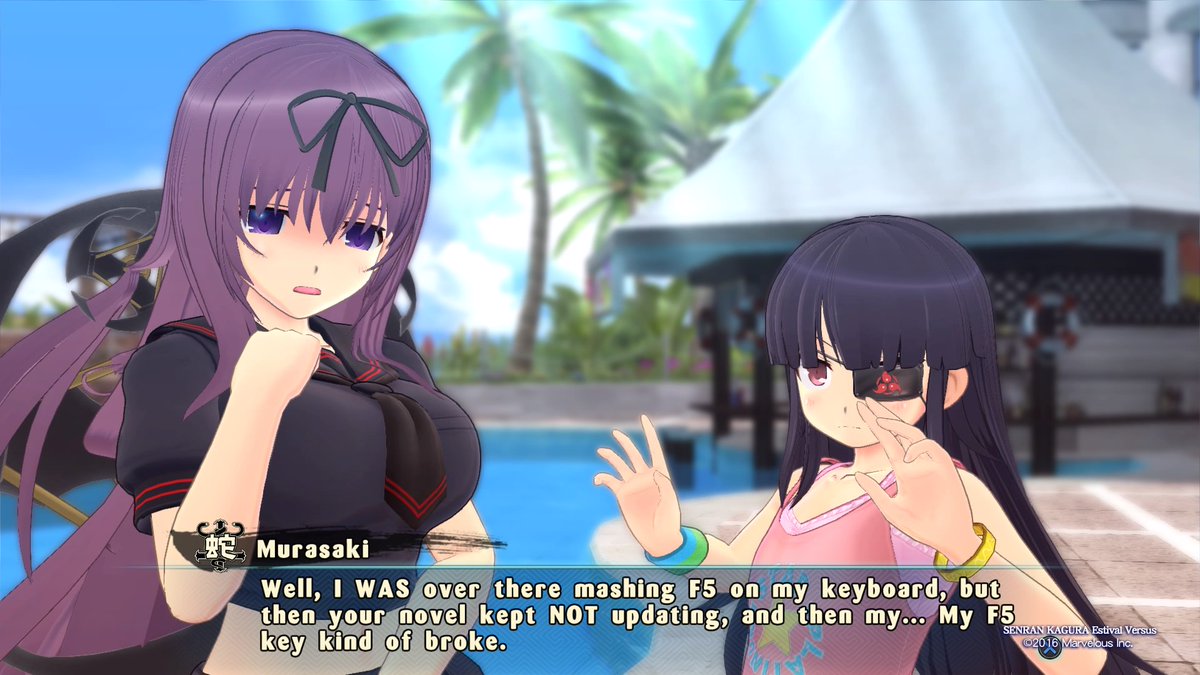 |
| Must be waiting for a new episode of Infamous Animation. |
There's very little to complain about in that regard, but some of the changes in the ultimate attacks I could do without. Miyabi, Yumi, Asuka and Homura all have super modes as their ultimate ninpo. Homura already had her crimson form as an attack in Shinovi Versus, but I prefer giant frogs and ice spiders over a temporary power-up.
 |
| New haircut? |
The biggest improvements Estival Versus brings is visuals. It is a gorgeous, beautiful game that is no doubt using the Vita to its fullest potential.
The environments range from relatively small to enormous. Being able to render wide open spaces with no slowdown at all is impressive and it's always an amazing view when you successfully pull off a long aerial raid to rise high into the sky and see it all, but it's even better when you look up close at the little details that bring them to life. There are all kinds of extra touches like vendor stands with Senran Kagura merchandise, a stream of hot water pouring into the middle of the hot springs stage and big, scenic views of Hebijo and Hanzo academies from their rooftops (completely different from the roofs in Shinovi Versus).
The biggest new stage details are the new "creative finishers". In every stage there are sections marked with a picket sign with an exclamation point on them. If you finish off an opponent near one of those signs, they'll be put through a humiliating situation. You see the finisher in single player, but in multiplayer you can only see them when they happen to you, in place of a respawn timer for some modes.
There are least 50 of them in the game and it's great fun discovering all the ridiculous ways you can give the enemies a coup de grace with the objects around you. They're all viewable in the gallery, so they're something to collect for completionists. I could do without the victims being stripped nude for them though. I was pleased that didn't happen in Senran Kagura 2 and I do not know why they brought that aspect back.
 |
| English translation is "adopt me." |
 |
| Very clever use of accessories here. |
The multiplayer aspect of the game is vastly improved over Shinovi Versus too. With the larger maps and refined gameplay, it's usually much less of a clusterfunk and there are more factors to keep things interesting, such as the new throwable bombshell items, giant puppet mechs, the aforementioned finishers and minutes of special events occuring, like giving every player an unlimited super gauge or marking a player as a fugitive to award whoever kills them. Multiplayer is wilder and more expansive than ever before and I'm always game for some this time around.
Apparently the PS4 version allows up to 10 players. Now that is a clusterfunk!
It's not too hard to find players on the Vita version at the time of this writing, so if you're patient enough you can get a full room for multiplayer fun. Can you imagine if they charged a bullshit monthly fee just to let players play online? That would be fucking stupid and insulting.
If all of that isn't enough for you, there's more Estival Versus to come with the DLC. A day 1 patch for the game put the English version up to speed with the Japanese version, giving us a handful of extra goodies for free. In addition to making Grandma Sayuri playable, it added new multiplayer modes, great new stages, Rin and Daidouji! Hell yes! Daidouji and Rin even have their own shinobi girls heart stories!
 |
| Tops my most played character list. |
Can you imagine if they only made these characters free for the first week? That would be fucking stupid and insulting.
The day 1 update also added accessories based on the Japanese magazine Famitsu. Apparently in Japan it was part of a promotion, but since Famitsu isn't in America, they let us Americans have it for free, much like the K.K. Slider outfit in Super Smash Brothers 4.
Since release, XSEED has been bringing out DLC the Japanese version has had. Like Shinovi Versus, a lot of them are accessories, but since the accessory count for Estival is a lot higher than in that game, it doesn't feel as much like a cash grab.
Other DLC characters are part of the DLC list, including Ayane from Dead or Alive, Ayame (the shopkeeper) and both Kagura and Naraku from Senran Kagura 2. The Ikki Tousen characters from the Japanese version are not planned for release at this time due to licensing issues, but no one likes that stupid anime anyway.
If you play against Japanese players using the Ikki Tousen characters they're replaced with characters using in-game outfits and hairstyles to act as different characters, all named after characters from the classical Chinese novel, Water Margin. To be honest, I think I might like their designs more than the originals.
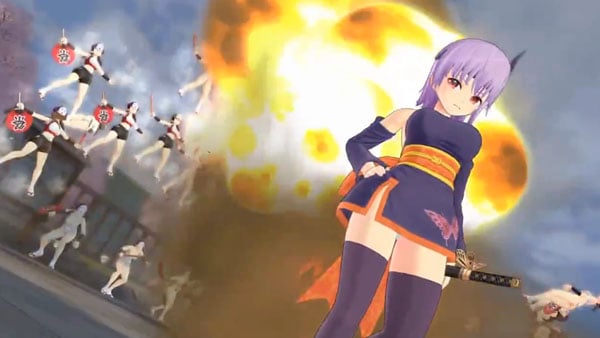 |
| I might get Ayane because Dead or Alive is actually good. |
If you lose at any point before wave 40 in shinobi survival mode, you can start over with a perfectly intact yagura from the wave you lost at, so long as you don't change the room settings or leave it. Make sure you have a good hour or so on your hand if you're going for all five badges. As raid modes do, it can get long and tedious, but it's a great way to level up characters. Unlike the other modes in which everyone is a set level, shinobi survival mode uses your stats from the main game.
As I was writing this review, another fun online feature was added: the Miss Shinobi contests. Not unlike the screenshot contests Super Smash Brothers Brawl used to have, in this mode players share dioramas, which are voted upon by other players. All you have to do is set them up like any diorama, get the angle you want and choose to upload it when it looks good. There's a free form contest where you share whatever you want, but every week there's a contest in which you have to make a diorama of specific characters. Participation in those gets you an exclusive accessory, one of the first of which is Bebe-tan, the cutest, most huggable thing in the series!
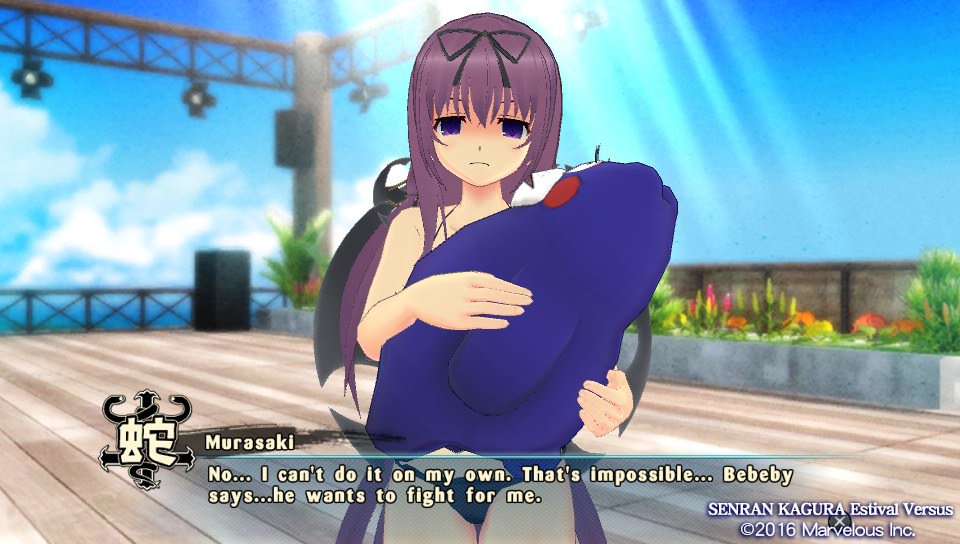 |
| There are few things better than blowing him up to three times his size for ultra huggability. |
I have to wonder what people who get the game later will do for the contest accessories though. My guess is they'll have the contests in an annual rotation or put the accessories up for purchase.
For voting you can see the rankings, the most recent posts and a casual slideshow of random entrants, which you can interrupt to give them a like. When viewing one of the dioramas outside of the slideshow, you can view the settings of everything used to make it. For fans of dioramas, it's fascinating to see what was used to create something different from the intended looks of accessories, and a lot of the entrants I've seen look really nice. This series has evolved into being part badass action and part fashion show!
All of this probably paints Estival Versus to be the best Senran Kagura yet, and I'm sure lots of people will think that. It is the best in a lot of ways, but I still think Senran Kagura 2 takes that distinction overall. There are a number of things Estival Versus falls short on compared to it.
1. Although it's very fun at its core, as any beat-em-up should be, Estival Versus doesn't change things up as much. Through the entire game you're only ever fighting the other characters, which was a complaint of mine in Shinovi Versus and still one now. It keeps things interesting by having you fight multiple characters at once, sometimes with an ally, and it has so many maps to use you won't get bored of the same location because luckily Sayuri's barriers simulate a variety of other environments whenever there's a fight on the island, which she specifically says is to keep things interesting.
But in spite of its effort to alleviate the feeling of repetition, there's no getting around the fact that it's still a series of fighting the other characters when something like a boss battle would have helped to add some variety.
Estival Versus does try to make Ryouki and Sayuri makeshift boss characters by saving them until toward the end and making them unlockable, but they're still ultimately just other playable characters bound by the same rules. The only time they enhance one of them enough to qualify as a boss is at the very end when the game pulls the age-old boss design of having one of the characters be in super mode infinitely. The fight itself is challenging and significant to the characters involved, but when compared it to Senran Kagura 2, I pine for something better.
Couple this with the previously-mentioned inconsequential plot and there isn't that much in Estival Versus that leaves a particularly lasting impact.
In Senran Kagura 2, Japan was under seige by monsters so an evil villain could get his hands on a relic that could grant him power with no effort at all, and doing so would basically set off a magic nuke; that had high stakes and urgency. With only 12 characters, most of them were able to get a fair amount of focus and screentime.
During the story, the villain made himself part youma and even used his own puppetry jutsu on himself in order to push himself to the max and turn into a hulking blue beast you have to fight with the two lead characters while he brags about his power in a warped, threatening voice and heavy head-banging guitar licks blare away.
It was metal! And only one of the game's many boss battles! Estival Versus can't claim to have moments like that.
2. On that note, I also think Senran Kagura 2 had a better soundtrack. It's a matter of taste, but I think Estival Versus' soundtrack dips into synthesized music one too many times and it's ultimately forgettable. Senran Kagura 2 had more hard-hitting guitar jams and heavy drum beats that stood out. Estival Versus still has some standout tracks of its own, of course, and they brought back the composer's notes too.
3. Senran Kagura 2 had a better English translation, overall. Estival Versus' is still fine, but the quirks in the XSEED's localization irked me one too many times in this one.
I was never a fan of the occasional F-bombs the English text dropped when it wasn't really what the characters were saying and now it exposes a glaring inconsistency.
When characters say a particularly bad swear, it's censored with the sound of explosions and gunfire for comedic effect, so when they're still using the F-word in the English text, it's strange that it's not censored out too. The English text also marks the censored dialogue with "*Bleep*", which is not the sound the game makes at all. Replacing it with symbol swearing or asterisks, like the Japanese version, would have made more sense.
All instances of the use of English are replaced with French in the English text, even though almost all previous uses of gratuitous English were translated as such. I understand changing the English language into something different when it's dubbed to make it still foreign, but this game is not dubbed! Anyone who can read the text knows English and can clearly tell what they are saying. Perhaps that was the intent and the change was only made to benefit people with the volume muted or the deaf, but there had to have been a better way around that.
 |
| Actual spoken line: "Hello! I am puritii Japanese ninja!" |
 |
| This is a larger scale yagura you can see on one of the festival grounds stages. |
I don't like to rail on XSEED. It's clear they care a lot about the franchise and gaming as a whole, but I don't think they give players enough credit sometimes.
4. When it comes to bonus characters initially unplayable with no transformation, I like Murasame more than Sayuri.
Make no mistake, I really like Sayuri. I like the casual way she fights with smoke and her giant pipe, but Murasame was much more fun to goof around with and unlike Sayuri, he takes clothing damage.
Part of what I thought was nice about Murasame was that him (and Dougen) getting his clothes shredded like anyone else further established that as the way damage is shown in these games and that it isn't discriminate toward women. It was consistent. Grandma Sayuri never takes clothing damage at all.
I suppose you could argue that she's not really trying, since her defeat animation has her coughing a little and brushing it off, but she's still getting hit. I guess it's because nobody really wants to see that, but they could have at least made a small part of her outfit show damage. Maybe her scarf, kind of like Ganondorf's cape in Ocarina of Time. It's not like you can change Sayuri's outfit. You can't even put accessories on her, unlike Murasame. And on the subject of accessories:
5. Senran Kagura 2 has much more accessory options than Estival Versus does. Estival Versus does step up on the accessory count from Shinovi Versus, thanks in part to most character's default accessories being interchangeable, but it's still dwarfed by everything Senran Kagura 2 had. Senran Kagura 2 also typically had at least five variants for every accessory, some of which had different designs and patterns in addition to color changes. In Estival Versus, every accessory typically only has one or two alternate colors. That's it. Outfits still have five color variants, but they took out most of the pattern changes, like Mirai's "The World" camisole. There's more outfits and accessories available for DLC, but that's another area Senran Kagura 2 did better in.
6. Senran Kagura 2's paid DLC has better dollar value than Estival Versus'. If we consider a new playable character to have the same value as a whole new story chapter and new feature to play with, 2 trounces the DLC in Estival Versus.
For a $5 DLC pack in Senran Kagura 2 (any of them), you get:
- A 5-chapter add-on story chapter involving-
- An extra gameplay feature
- Several new accessories with different variants
- A handful of new outfits with their own variants
- Some new hairstyles
- Some extra backgrounds for photo shoot mode
- Sports-themed weapons for the 10 main characters, at least in the first pack
For Estival Versus' $6 Dead or Alive bundle you get:
- An extra playable character
- One accessory
- Three outfits
- One hairstyle
- A new music track
It's an extra dollar for a lot less. You could argue that the effort put into the detail for the clothing destruction and music justifies it, but I don't think so. The free updates to the multiplayer is definitely an advantage to Estival Versus though.
Like every other Senran Kagura game, Estival Versus is still fun. It's as much of a big step up from Shinovi Versus as Senran Kagura 2 was for the first game, but just like Shinovi Versus, it does much better in some areas than the game before it, but also falls short in others. Estival Versus' many characters, much expanded features and the updates adding even more features will keep fans happy for quite a while and it may well be the go-to Vita game for flashy anime multiplayer battles, but once again I feel it's not quite reaching the series potential, especially not with its haphazard plotting
I give Senran Kagura: Estival Versus a 7.5 out of 10.

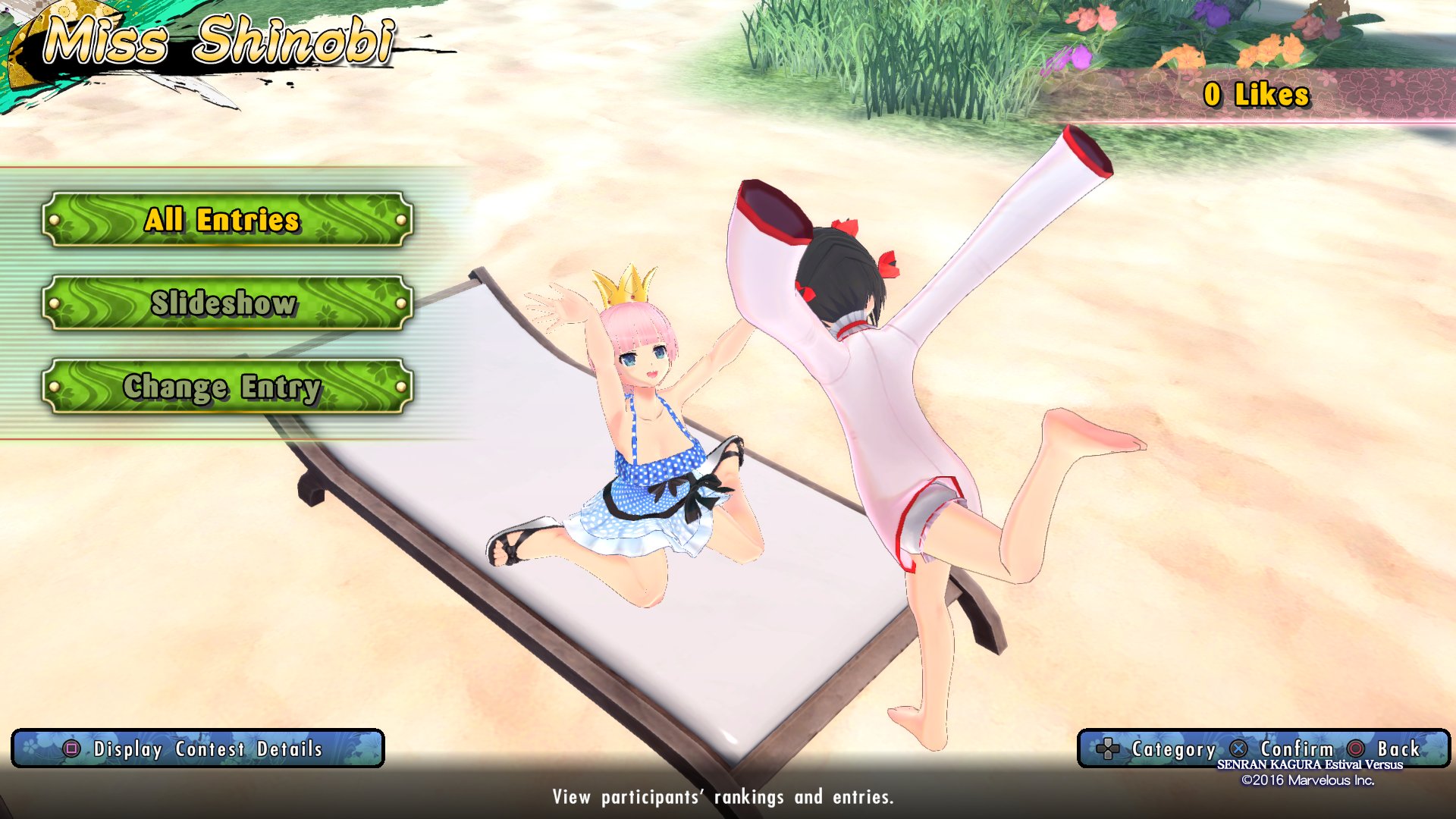


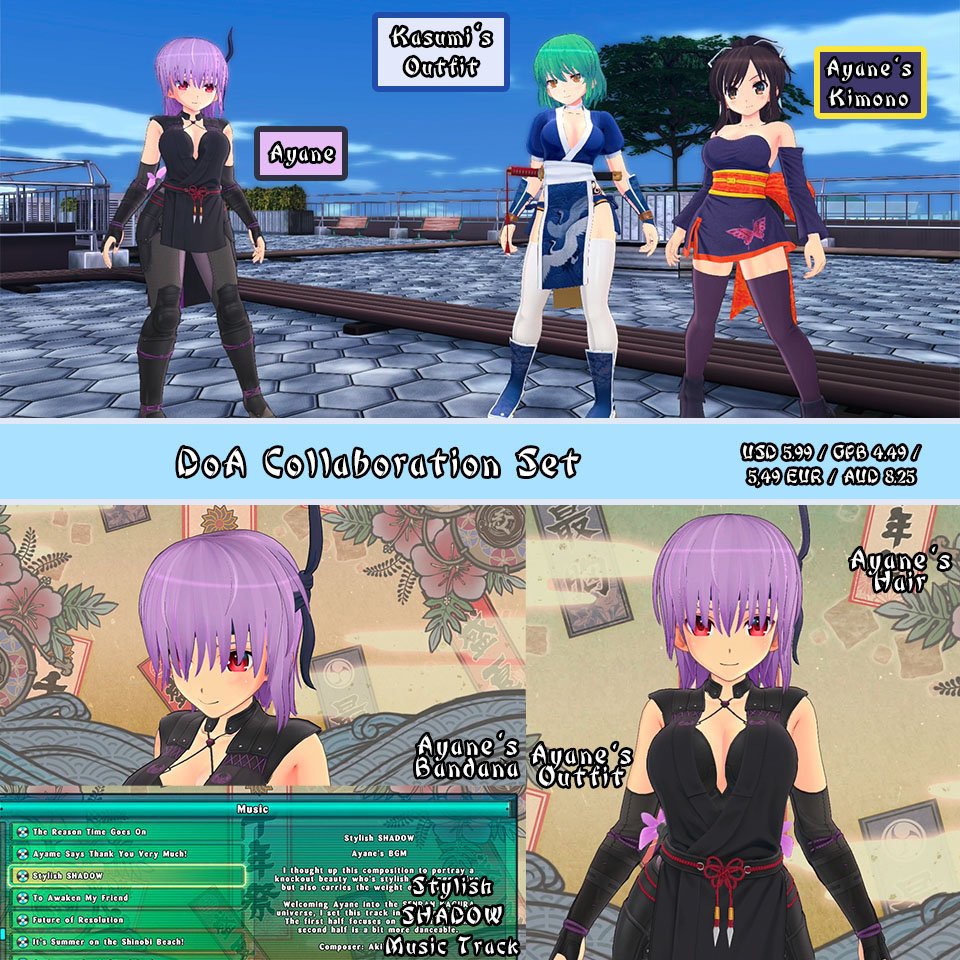
No comments:
Post a Comment